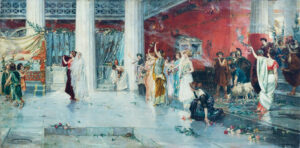By Giselle P. Kasilag
IT WAS a homecoming of a historical and cultural significance on a scale that has never been witnessed by the country before. Hymen, oh Hyménée, also known as Boda Romana (Roman Wedding), has never been in the Philippines since it was painted by Juan Luna, and has not been seen in public since it was exhibited at the Exposition Universelle 1889 in Paris, until now.
“Tonight, we commemorate the 125th anniversary of Philippine nationhood with the unveiling of a long-lost masterpiece by Juan Luna, never before seen on Philippine shores,” said Mariles Gustilo, senior director of Ayala Foundation’s Arts and Culture Division. “Titled Hymen, oh Hyménée and widely regarded by art collectors as the holy grail of Philippine art, this masterpiece was last seen in public 132 years ago in Paris after winning bronze in the groundbreaking 1889 Paris World’s Fair of the Eiffel Tower fame, once again confirming Luna’s position among the best painters of the Western world in the late 19th century, earning not only for himself but for many Filipinos a sense of dignity and pride at a turning point in our own country’s history — our quest and struggle for independence.”
The masterpiece is now at the Ayala Museum. The exhibit, “Splendor: Juan Luna, painter and hero,” is open for public viewing until Dec. 31. Admission is free on June 12, from 12 p.m. to 6 p.m.
THE SEARCHBorn in Badoc, Ilocos Norte in 1857, Juan Luna was a painter, sculptor, and a political activist along with his brother General Antonio Luna and their good friend, the national hero Jose Rizal. He is best known for Spoliarium which won him the first prize in the 1884 Exposición Nacional de Bellas Artes.
He married María de la Paz Pardo de Tavera in 1886. Her likeness was painted into Hymen, oh Hyménée — the small figure of a bride located on the left side of the painting. Wrapped in a veil, she appears confused and uncomfortable. According to the museum notes, Luna painted a turtle on the floor to symbolize his “desire for his bride to be submissive and happy in the privacy of her home.” That happiness was short lived. Six years later, in a fit of jealousy, Luna killed her, her mother, and wounded her father as well.
The artwork remained in the possession of Luna until his death in 1899. Its whereabouts became a mystery afterwards. A document mentioned that it was at the Louvre. Some said it was burned by the Pardo de Tavera family, still angry with the murder of Maria dela Paz and her mother. Others thought it was destroyed during the war.
Leon Gallery owner Jaime Ponce De Leon, however, was unconvinced.
“The end of a very long and exciting journey,” was how he described the relentless search for the masterpiece.
“The mystery of its existence only grew with the engravings and mentions of the splendor in 19th century publications. But where was it? Nobody knew. My own story began some 15 years ago when I first heard of the treasure. By then, it was the ultimate grail of Philippine art. Much-talked about by collectors, much-revered, but nowhere to be found. That, of course, made it even more tantalizing!” he explained.
He explained that it was Dr. Eluterio “Teyet” Pascual who first saw the painting about 50 years ago. But because he sang such high praises for it, Mr. Ponce De Leon found himself doubting it.
“It was, I thought, the greatest painting that didn’t exist!” he claimed. He added that apart from Dr. Pascual, he knew of only one other person who was familiar with the piece. But no one would give him a lead.
“The dream of finding it would, thus, become a tireless obsession and I would find myself hunting galleries and dealers — famous and some infamous — all over Europe, courting old maids and befriending aristocrats and everybody and anybody in between with some connection to Juan Luna and to the Philippines. It would always be futile, and my hopes always dashed. And then one day in 2014, I got a call and was told to be at the doorstep of a certain aristocratic home in a European city by 10 a.m. sharp. And there I was, I could not believe what was revealed and finally lay before me. It was the grail,” he recounted.
BRIDAL PARTYThe masterpiece features representations of a bridal party set against an ostentatious hall with marble columns, thick draperies, and lots of fresh flowers. It was unlike its contemporaries that often highlighted the gods and powerful figures. This piece was clearly intimate and extremely personal.
On display at the museum accompanying Hymen, oh Hyménée are studies showing Luna’s process in preparing to paint the large composition. Indeed, the Ayala exhibit is a treasure trove for artists and historians whose future research could lead to a better understanding of Luna’s genius.
“Splendor: Juan Luna, painter and hero” is supplemented by a film documentary and a catalogue. The exhibition analyzes the masterpiece through three things: the world of 1889, Juan Luna the painter as hero, and the imagery of the painting itself.
The finding of “Hymen, oh Hyméné” has immediately changed the landscape of Philippine art and one can only expect that many new theories about Luna will soon come to light.
